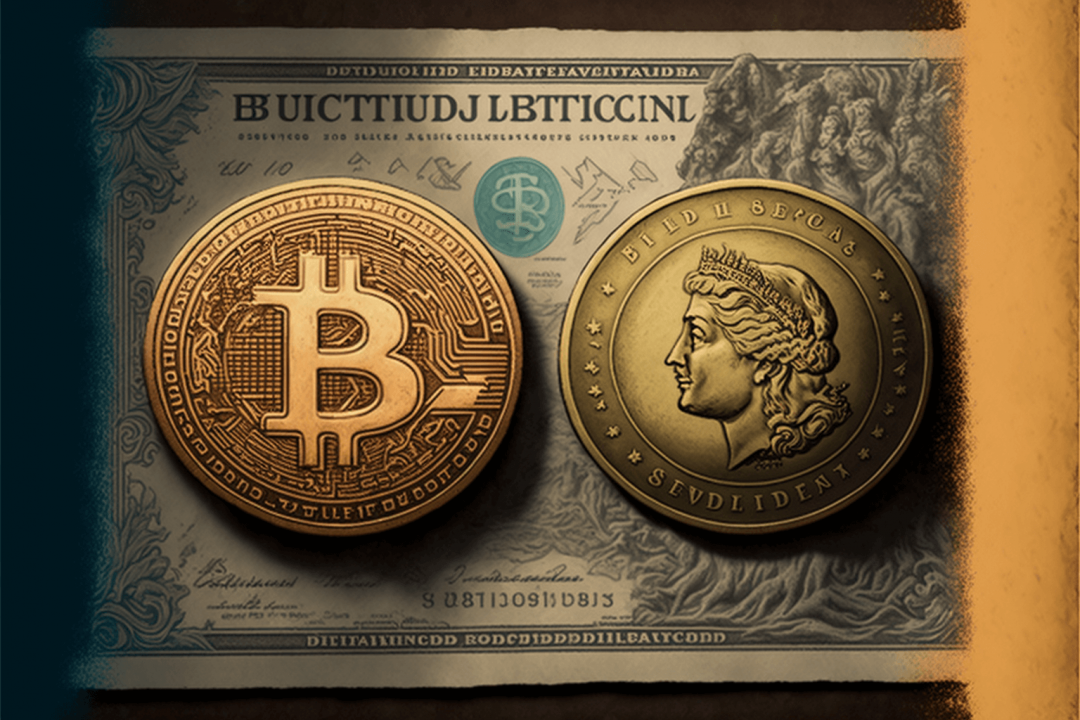Are you curious about Bitcoin, but feeling overwhelmed by all the technical jargon? Look no further! This guide will break down the complexities of Bitcoin and provide a comprehensive overview for beginners.
You’ll gain an understanding of how Bitcoin works, its history and potential impact on the global economy. We’ll also delve into the intricacies of blockchain technology, and explore the different ways you can buy and store Bitcoin.
By the end of this guide, you’ll be equipped with the knowledge and skills needed to navigate the world of Bitcoin like a pro. Keep reading to discover the exciting world of Bitcoin!
I. The Basics of Bitcoin
Definition: What is Bitcoin, and how does it differ from traditional currencies?
Bitcoin is a digital currency that allows for peer-to-peer transactions without the need for a central authority. It is decentralized, meaning it is not controlled by any government or financial institution. It uses blockchain technology to keep track of all transactions and ensure that the system is secure.

One of the main differences between Bitcoin and traditional currencies is that Bitcoin is not backed by any physical commodity or government. Instead, it relies on the trust of its users and the security of the blockchain technology. This means that the value of Bitcoin is determined by supply and demand in the marketplace, similar to stocks or other investments.
Another difference between Bitcoin and traditional currencies is the way transactions are processed. Traditional currencies are processed through banks or other financial institutions, while Bitcoin transactions are processed through the decentralized network of users on the blockchain. This makes transactions faster, cheaper, and more secure.
Additionally, Bitcoin is not bound by any geographical boundaries. Bitcoin transactions can be sent and received from anywhere in the world, in a matter of minutes, and with low transaction fees, making it more accessible and efficient for global transactions.
Technology: How does the blockchain technology work, and why is it important for Bitcoin?
Blockchain technology is revolutionizing the way we think about recording and sharing information. It is a method of recording information that makes it impossible or difficult for the system to be changed, hacked, or manipulated. A blockchain is a distributed ledger that duplicates and distributes transactions across the network of computers participating in the blockchain.
At its core, blockchain technology is a structure that stores transactional records, also known as the block, in several databases, known as the “chain,” in a network connected through peer-to-peer nodes. Think of it like a Google spreadsheet shared among numerous computers in a network, in which the transactional records are stored based on actual purchases. The fascinating angle is that anybody can see the data, but they can’t corrupt it. This makes it an incredibly secure way to store and share information.
But blockchain technology isn’t just about security. It’s also a powerful tool for facilitating transactions and exchanges. Every transaction in this ledger is authorized by the digital signature of the owner, which authenticates the transaction and safeguards it from tampering. This digital signature is created using cryptographic keys, which consist of two keys – Private key and Public key. These keys help in performing successful transactions between two parties.
In recent years, you may have noticed many businesses around the world integrating Blockchain technology. From finance to healthcare to supply chain management, the potential applications of blockchain are endless. But what makes it so revolutionary? It’s the combination of three leading technologies: cryptographic keys, a peer-to-peer network containing a shared ledger, and a means of computing, to store the transactions and records of the network.
Mining: What is the process of mining Bitcoin, and how does it ensure the security of the network?
Bitcoin mining is an essential process that ensures the security and integrity of the Bitcoin network. It is the process of providing a stable settlement mechanism to the network of a cryptocurrency by verifying legitimate transactions in the blockchain. Miners are computer owners who contribute their computing power and energy to the network of a “proof-of-work” based cryptocurrency like Bitcoin.
In order to mine Bitcoin, miners need two things: mining hardware and energy. They use their computer’s processing power to solve complex cryptographic puzzles to validate new blocks for the blockchain. The first miner to find the solution gets a specific amount of newly minted bitcoins as a reward, called a block reward. This reward gives everyone in the network the incentive to participate in the process and keep it running properly.
The process of mining Bitcoin works by collecting and bundling individual transactions from approximately the past ten minutes into blocks. Miners’ computers, called nodes, then compete to solve the cryptographic puzzle and validate the new block for the blockchain. This puzzle-solving mechanism is necessary to protect the Bitcoin network from being compromised by attackers. For example, if anyone wanted to reverse transactions in the Bitcoin blockchain, it would take 51% of the whole network’s computing power – which is a very difficult and expensive endeavor.
As more and more units of Bitcoin are mined, the difficulty of these cryptographic puzzles increases. This means miners have to increase their computational power to continue earning the same amount of Bitcoin for solving puzzles. The Bitcoin protocol stipulates that there will never be more than 21,000,000 bitcoins, which means that the Bitcoin supply is finite, and the complete supply is fixed, potentially adding to its value as a result of scarcity.
II. History of Bitcoin
Origin: Who created Bitcoin and why?
Bitcoin, the first and most well-known cryptocurrency, was created in 2009 by a person or group of people using the pseudonym Satoshi Nakamoto. This pseudonym appeared on the original 2008 Bitcoin white paper that first described the blockchain system that would serve as the backbone of the entire cryptocurrency market. Despite much speculation, the true identity of Satoshi Nakamoto remains unknown.
The origins of Bitcoin can be traced back to the global financial crisis of 2007 to 2009, a time when distrust of banks and central governments was at a peak. Many early Bitcoin enthusiasts were captivated by its design, even if they weren’t exactly certain of what it was going to be used for. Joshua Peck, founder and chief investment officer of cryptocurrency hedge fund TrueCode Capital, recalls that early adopters of Bitcoin saw value in its engineering and thought it could be used for secure message passing or getting strong cryptography into the hands of everyday users.

The Bitcoin blockchain was officially launched when the first Bitcoin block, the genesis block, was created on Jan. 3, 2009. In the first seven months following Bitcoin’s launch, Satoshi reportedly mined up to 1.1 million Bitcoins. At August 2022 prices, those coins would now be worth about $22 billion.
Early days: How did Bitcoin gain traction in its early years?
In its early days, the concept of Bitcoin was not well understood, and it faced a lot of skepticism and resistance. But despite the odds, Bitcoin managed to gain traction and grow in popularity.
One of the major factors that helped Bitcoin gain traction in its early years was its decentralized nature. Unlike traditional currencies, Bitcoin was not controlled by any central authority or government, which made it an attractive option for people who wanted to avoid the traditional financial system.
Another factor that helped Bitcoin gain traction was its use as a means of payment. The first reported real-world financial transaction involving Bitcoin took place on May 22, 2010, when a Florida man negotiated to pay 10,000 BTC for two Papa John’s pizzas priced at about $25. This transaction valued the price of one Bitcoin at roughly a fourth of a cent. To this day, the Bitcoin community celebrates Pizza Day on May 22, to commemorate this historic transaction.
As Bitcoin’s value wasn’t widely understood in its early days, it was mainly used by tech enthusiasts. However, as more and more people began to realize the potential of Bitcoin, its value began to increase. This led to a surge of interest in Bitcoin and other cryptocurrencies, and the number of people using Bitcoin began to grow exponentially.
As Bitcoin’s popularity grew, more and more businesses began to accept it as a form of payment. This helped to further legitimize the currency and made it more accessible to the average person.
Another important factor in Bitcoin’s early days was the emergence of online exchanges that allowed people to buy and sell Bitcoin easily. These exchanges made it easy for people to get involved with Bitcoin and helped to further increase its adoption.
Current state: What is the current state of Bitcoin, and where is it headed in the future?
In the past decade, Bitcoin has seen its fair share of ups and downs, but it has managed to establish itself as a viable and valuable asset in the financial world. The current state of Bitcoin is one of steady growth and increasing mainstream acceptance.
In 2022, crypto delivered its worst performance since 2018, but investors are hoping 2023 will usher in a repeat of the 2019 market rebound. Crypto exchange Bitbank projects that Bitcoin prices will recover to between $20,000 and $50,000 in the second half of 2023, but only if the Federal Reserve can stop interest rate hikes by mid-2023 and begin cutting rates by early 2024.

VanEck analyst Matthew Sigel has predicted that Bitcoin will recover to $30,000 in 2023, but warns it could remain in the $10,000 to $20,000 range in the first quarter of the year. However, Standard Chartered has cautioned investors that crypto winter will extend into 2023, leading to more liquidity issues and bankruptcies, as well as further deterioration of investor confidence. Standard Chartered says Bitcoin prices could fall another 70% to around $5,000 in 2023.
Despite the mixed predictions, Bank of America analyst Alkesh Shah believes that recent cryptocurrency price declines and bankruptcies have overshadowed the long-term thesis for digital assets and blockchain technology. He says, “We expect the digital asset ecosystem’s market value to trade in line with risk assets over the course of 2023, but see the potential for token price divergence as investors shift focus from speculative trading to the development and adoption of blockchains and applications powered by tokens with utility and cash flows.”
Shah also points out that “the digital asset ecosystem is still a nascent industry, and it will continue to develop in 2023” and that “Bitcoin is 14 years old, but dozens of blockchains and hundreds of applications have emerged that are less than 3 years old and remain in version 1.0”.
III: Buying and storing Bitcoin: Where and how to do it
Investing in Bitcoin (BTC) may appear complicated at first, but it becomes more straightforward once you break it down into parts. For example, Bitcoin investment or trading BTC requires a service or an exchange account, while additional secure storage methods are advised. To buy Bitcoin, you will need:
- A cryptocurrency exchange account
- Personal identification documents if using a Know Your Customer (KYC) platform
- A secure internet connection
- A payment method (bank accounts, debit cards, and credit cards are all acceptable)
You can also buy Bitcoin through Bitcoin ATMs or peer-to-peer (P2P) exchanges, but starting in early 2020, Bitcoin ATMs progressively required government-issued identities. Keep in mind that Bitcoin is volatile, so it’s essential to know what you’re getting into and have a crypto investment strategy in place. Don’t invest just because you’re afraid of missing out.

As more options become available for buying Bitcoin, it can be overwhelming to figure out which method is best for you. But don’t worry, by following the steps outlined in this post, you can learn how to easily invest in BTC and choose the method that best fits your needs.
Step 1: Choose a Cryptocurrency Exchange
When it comes to buying Bitcoin, the first step is to choose a cryptocurrency exchange that suits your needs. There are a variety of exchanges available, each with their own set of rules and regulations. It is important to choose an exchange that is located in your region and that follows the necessary Know Your Customer (KYC) and Anti-Money Laundering (AML) practices. There are two main types of exchanges: centralized exchanges and decentralized exchanges (DEXs). Centralized exchanges are online platforms where you create an account, provide personal information, and can trade various assets. DEXs, on the other hand, allow you to make trades from your wallet.
- Binance, if you care about altcoins a lot
- Kraken, if you are looking for a safe and reputable exchange
- Coinbase, if you want to buy bitcoin easily and store it right there like in the bank (a bit more expensive)
- Cake DeFi, if you want to not only buy Bitcoin, but also earn interest on it
Step 2: Decide on a Payment Option
The next step is to decide on a payment option. Different exchanges accept different forms of payment, such as bank transfers, debit cards, credit cards, and PayPal. It is important to note that you will need to authenticate your identity and provide additional documents, such as a state-issued ID or passport, regardless of which payment option you choose.
Step 3: Place your Order
Once you have been verified and deposited money into your account, you can place your order to buy Bitcoin. The process varies depending on the exchange, with some allowing you to purchase BTC by just pressing a button and entering the amount you want to buy. Most exchanges also provide three fundamental order types: market order, stop order, and limit order.
Step 4: Store your Bitcoin
The final step is to store your Bitcoin in a safe and secure wallet. There are various types of wallets available, such as desktop, mobile, online, hardware, and paper wallets. It is important to note that your wallet does not technically store your Bitcoin, but rather holds private keys that are essential for accessing your Bitcoin address and spending the funds. Losing these keys means losing access to your Bitcoin, so it is important to choose a secure and reliable wallet.
How to buy Bitcoin with PayPal
Buying Bitcoin with PayPal can be difficult depending on your location, as most exchanges avoid this payment method due to the risk of chargebacks. Transactions made using credit cards or PayPal can be reversed, while Bitcoin transactions are irreversible. To buy Bitcoin with PayPal, you’ll need to create an account and have accessible funds or a linked debit card or bank account. PayPal, like other crypto exchanges, charges a fee for buying and selling cryptocurrency.
How to buy Bitcoin with a credit card
Buying Bitcoin using a credit card can be done on several crypto exchanges, but it comes with additional fees. These fees include transaction fees and broker fees. Additionally, foreign transaction fees may be applied if the exchange is based outside of your home country. The credit card issuer’s policies also play a role in the ability to purchase crypto with a credit card. To set up a transaction, a credit card must be linked and verified, similarly to linking and verifying a bank account via ACH in the US.
How to safely store Bitcoin

Before buying Bitcoin, you will need a place to store it. In the world of cryptocurrency, that place is called a “wallet.” Crypto wallets come in a variety of forms, and different types of wallets provide BTC owners with many kinds of security, storage, and access options. The five main types of BTC wallets are:
- Desktop wallets:
A desktop wallet is installed on the user’s computer, providing control of funds they send to that wallet. Thick desktop wallets allow users to download the related blockchain in its entirety, and it provides independent security management of their funds. On the other hand, thin wallets don’t require users to download blocks and can be easily downloaded to a portable device. - Mobile wallets:
The main advantage of a mobile wallet is that the user’s funds are always on hand. It can be a convenient way of paying for goods by scanning QR-codes. In some cases, users can take advantage of their smartphone’s near-field communication feature, otherwise known as NFC, which allows them to just simply tap their phone against a reader without entering any information at all. - Online wallets:
If using a web-based wallet, users’ private keys are stored on an online server controlled by someone else and connected to the internet. While it allows people to easily access their funds from any device from virtually anywhere in the world, there is always a risk of the server being hacked or even the organization running the service taking control of your Bitcoin. - Hardware wallets:
These wallets are dedicated portable devices that hold private keys offline. They are considered to be the most secure way to store Bitcoin, as they are not connected to the internet and are therefore not vulnerable to hacking. - Paper wallets:
A paper wallet is a physical representation of your private and public keys. It can be generated and printed out, and it’s an easy way to store small amounts of Bitcoin offline.
It’s important to note that your wallet doesn’t technically store your Bitcoin. Instead, it holds private keys, which are essential for accessing a Bitcoin address and being able to spend the funds. These digital keys are required to sign transactions, and if a user loses them, they essentially lose access to their Bitcoin.
Conclusion
In conclusion, Bitcoin is a complex and constantly evolving digital currency that has the potential to change the way we think about and use money. This guide has provided a beginner’s overview of Bitcoin’s technology, history, and how to buy and store it. As the world becomes increasingly digital, it’s important to stay informed about the potential of technologies like Bitcoin. We encourage readers to continue learning about Bitcoin and consider its potential in their own lives. If you want to learn about everything you can do with Bitcoin to achieve financial freedom, you can sign up for Dr. Julian Hosp’s Decentralized Finance course for free here: https://academy.julianhosp.com/en

Navigating the crypto jungle can be overwhelming, but with the right mindset and precautions, you can safely make informed decisions. The key to success in the world of crypto is to DYOR – Do Your Own Research. As a crypto enthusiast, it’s important to remember that you are your own bank, so always proceed with caution and skepticism. Never invest more money than you are willing to lose, and use the strategy of dollar cost averaging (DCA) by investing regularly and in small amounts.
Safety should be of utmost importance, take good care of your backups and store them protected from fire and water, never save them digitally. It’s also crucial to take measures to ensure that your relatives have access to your cryptocurrencies in the event of an accident. Remember, investing in crypto is not just about making profits, it’s about being part of a revolutionary technology that has the potential to change the world.
References
- https://bitcoin.org/bitcoin.pdf
- https://github.com/bitcoin/bitcoin
- https://bitcoin.org
- https://wikipedia.org/wiki/Satoshi_Nakamoto
- https://wikipedia.org/wiki/Bitcoin
- https://coinmarketcap.com
- https://www.coingecko.com
- https://www.facebook.com/groups/cryptofit/
- Book “Cryptocurrencies simply explained” by Dr. Julian Hosp
- Book “The Bitcoin Standard” by Saifedean Ammous

